The Huayhuash Circuit is considered as one of the best alpine treks in the world. The trail encircles the spectacular mountain range of Cordillera Huayhuash, including the impressive peaks of Yerupajá (6,617 m / 21,709 ft), Siula (6,344 m / 20,814 ft) and Sarapo (6,127 m / 20,102 ft).
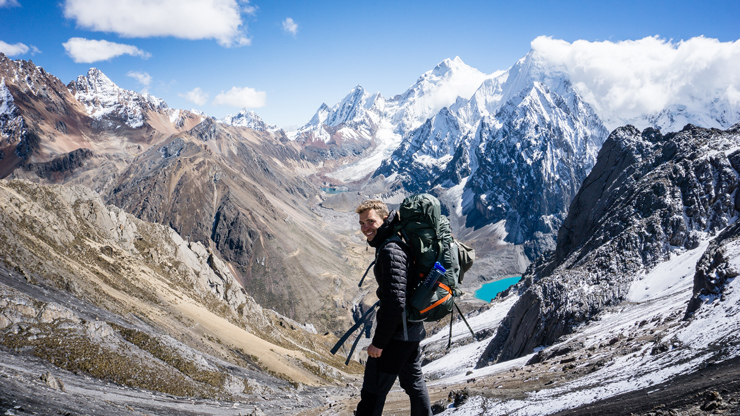
Cordillera Huayhuash is still a remote part of the Peruvian Andes. Unlike the more popular Santa Cruz trek or Inca Trail, you will escape the crowds and most of the time won’t have to share this unique setting with anyone. That’s probably because the hike is also higher, longer and more strenuous. While it doesn’t require technical mountaineering skills, be aware that it is a tough trek, especially when hiking independently. The trail takes 8 to 12 days to complete, rarely drops below an altitude of 4,000 m (13,123 ft) and let you cross a pass of 4,650 m (15,256 ft) to 5,050 m (15,568 ft) each day.

That being said, it is definitely doable when you have some experience with multi-day hikes and, rest assured, the reward is priceless. You’ll be constantly surrounded by the scenic untouched beauty of majestic snow-capped granite peaks, stunning alpine meadows, imposing roaring glaciers and pristine azure lakes. But most of all, you’ll collect moments and a sense of accomplishment that will last a lifetime!
When to go
The best time to hike in the Cordillera Huayhuash runs from May to September. This is the dry season or the Andean Summer. While temperatures are a bit lower (expect temperatures below -10 °C / 14 °F at night) you’re more likely to witness the giant peaks in full exposure.
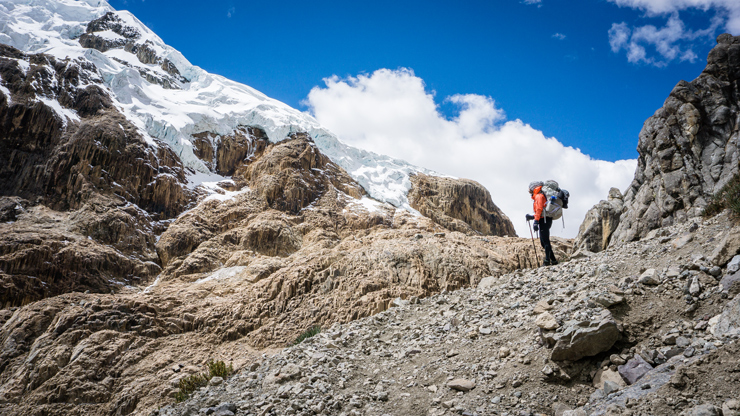
In wet season, chances are that you’ll see not much more than clouds, clouds and clouds. Unfortunately, the dry season doesn’t guarantee you a 100% dry trek at all. Be prepared for some rain, hail and even snow.
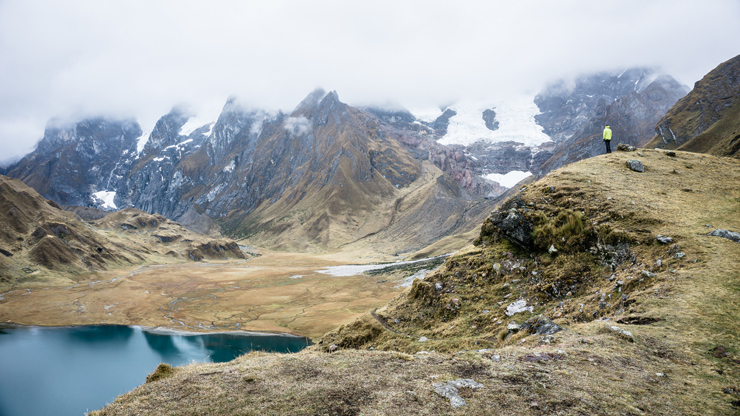
How to get there
The cheapest way to reach the Cordillera Huayhuash is by public transportation. From Huaraz, you’ll first need to take the bus to Chiquián, which will cost you 10 soles per person and take about 2.5 hours. There you have to change bus to Pocpa (another 15 soles per person) and have 2 options:
- Or you get off the bus in Llamac after about 1.5 hours, to hike the full classical circuit. The first stretch to Laguna Jahuacocha basically backtracks the last stretch of the circuit. The trail then continues to Matacancha, past Sambuya Punta (15,551 ft / 4,740 m) and Rondoy Punta (15,584 ft / 4,750 m).
- Or you continue on for an extra half an hour to Pocpa, which is the outermost village you’ll get with public transport. Then, you still need to walk about 7.5 miles (12 km) on not-the-most-scenic mining road to Matacancha. This way, you instantly cut 1.5 days without missing too much, which is interesting for those who’re limited on travel time.
The easiest way to get to the Huayhuash Circuito is to book private transportation in Huaraz. There are a couple of advantages. It is more convenient, as you’ll be picked up at your hostel in Huaraz and don’t need to change bus. Moreover, unlike the public bus, the private one brings you all the way to the Quartelwain campsite – also referred to as Matacancha. Therefore, it is much faster and allows you to do the Huayhuash circuito on 8 or 9 days. Once arrived in Matacanha, you can chose to spend the first night there or immedeately start walking. Of course, the downside of this route option is that it is a more expensive solution. How expensive it is for you, is depending on the size of your group. Count on 400 soles for an 8 person minivan.
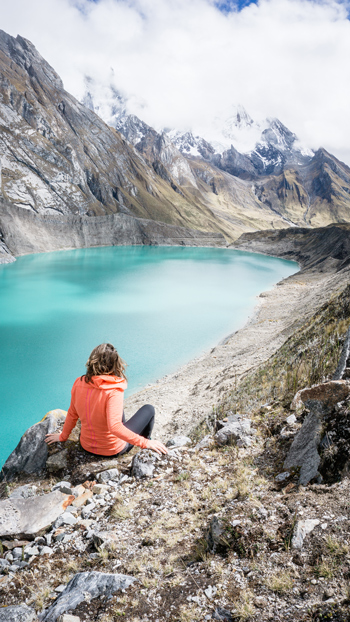
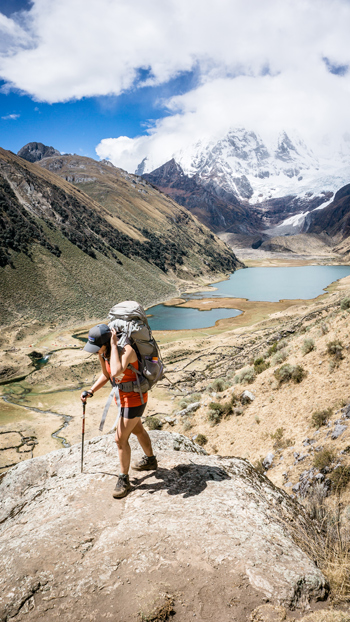
We were planning to take the cheap but longer option of public transport to Pocpa, as the price difference for a group of two is quite big. However, during our day hike to Laguna 69 we met a group of six Dutch hikers who were planning to start the Huayhuash Circuito on exactly the same day as us. There were 2 spots left in the van – we didn’t doubt. The hectic and time-consuming public transportation option would have cost us 50 soles together. The private transportation with pick-up at our hostel was now only 100 instead of 400 soles. That’s a whole other story!
Our itinerary
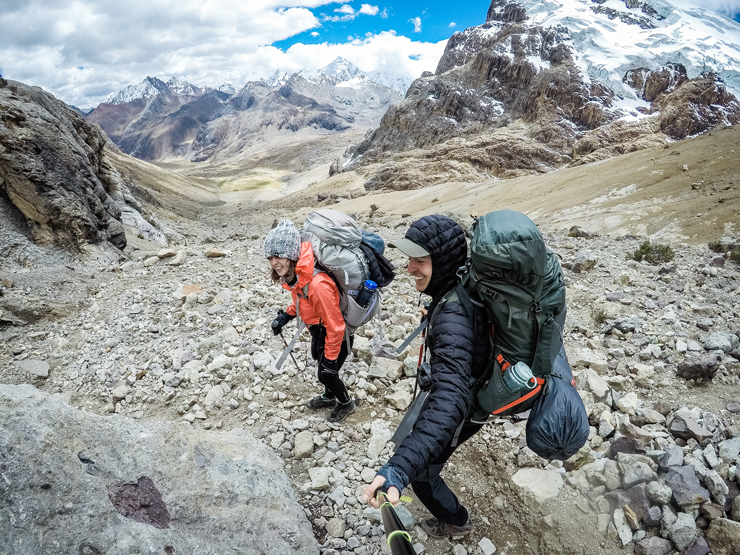
We started our trek in Matacancha and followed more or less the classical route, with some slight deviations. For a detailed description of our itinerary, please read our other post.
- DAY 1: Huaraz – Matacancha – Qaqanan pass – Mitucocha
- DAY 2: Mitucocha – Carhuac pass – Carhuacocha
- DAY 3: Carhuacocha – Siula pass – Huayhuash
- DAY 4: Huayhuash – Portachuelo pass – Viconga Hot Springs
- DAY 5: Viconga Hot Springs – Cuyoc pass – Guanacpatay
- DAY 6: Guanacpatay – San Antonio pass – Huayllapa
- DAY 7: Huayllapa – Tapush pass– Guspha
- DAY 8: Guspha – Yaucha pass – Jahuacocha – Pampa Llamac Pass
- DAY 9: Pampa Llamac Pass – Llamac – Huaraz
Note: If you want to return to Huaraz at day 9, you will need to take the bus at 11 am in Llamac. When camping in Jahuacocha on day 8, that means a bitter early start the next morning! That’s why we chose to push ourselves on to the Pampa Llamac Pass and granted ourselves a leisurely last morning in this breathtaking scenery.
Entrance and camping fees
Although you hardly see anyone on the trail, you pass various communities during the trek. To enter each of these communities, you’ll be charged an entrance fee which varies from 10 to 40 soles. The fees cover the usage of the trail, campsites and toilets. Don’t expect any luxury though.
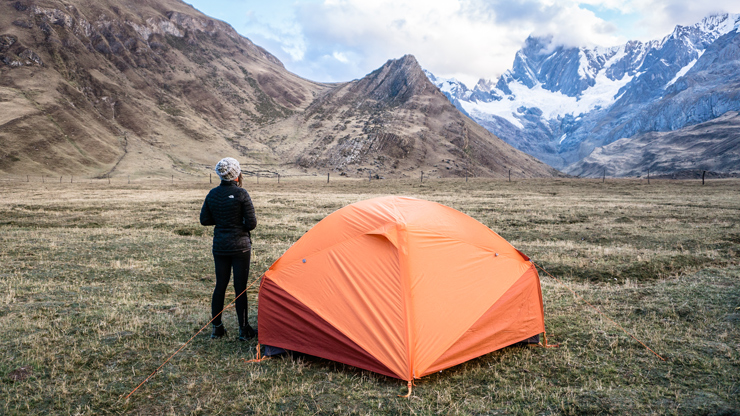
But most of all, the fee system contributes to the safety of the hikers. The local communities now benefit from tourism and sometimes even provide night patrol guards. There were indeed a couple of incidents in the past, but since the introduction of the fee system, the circuit is considered safe. We can confirm that we never felt worried about our safety.

The fees are typically collected at the camp spots. However, always keep your ticket as it is possible you’ll be asked for it along the way too. In total, expect to pay 190 soles per person along the entire circuit, although this can vary according to the route you take.
| Community | Campsite | Fee |
|---|---|---|
| Llámac | Matacancha/Cuartewain | S/. 20.00 |
| Pocpa | none | S/. 10.00 |
| Queropalca | Mitucocha, part of Carhuacocha | S/. 40.00 |
| Quisuarcancha | part of Carhuacocha | S/. 20.00 |
| Tupac Amaru | Huayhuash | S/. 20.00 |
| Uramaza | Viconga lake, hot springs | S/. 20.00 |
| Huayllapa | Viconga, Guanacpatay, Cutatambo and Huatiaq | S/. 40.00 |
| Pacllon | Qashpapampa, part of Jahuacocha | S/. 20.00 |
Altitude sickness
At high elevations, there is less oxygen in the air. If you climb too quickly, your body doesn’t have the time to adjust to this low amount of oxygen. In that case, symptoms like headache, dizziness, nausea and vomiting can occur and ruin your trip. This is called altitude or mountain sickness. In extreme cases – if you don’t admit to it and keep climbing – the consequences can even be fatal. But don’t let that stop you from your big adventure in the mighty Cordillera Huayhuash. If you take the appropriate precautions, there shouldn’t be any problem. It is important to realize that anybody can suffer from altitude illness. Some people are less sensitive to it than others, but nobody is immune to it. Also being fit doesn’t reduce the risk of altitude sickness.
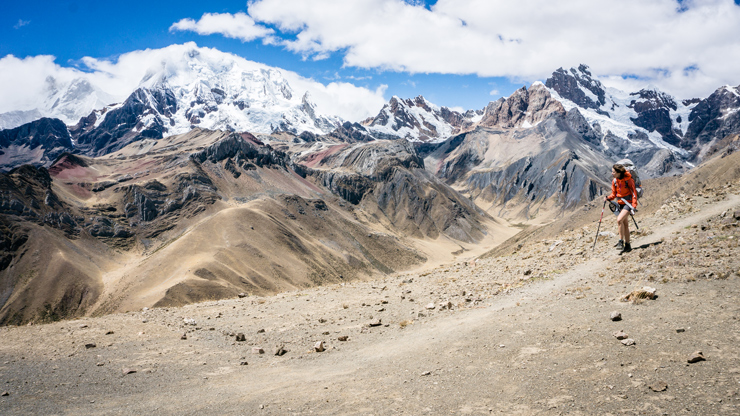
Most people we met during the hikes in Peru were taking acetazolamide tablets (Diamox) to prevent and reduce the symptoms of altitude sickness. We didn’t, as we never took them and thus didn’t know what to expect as side effects. However, we strongly believe the best way to prevent altitude sickness is taking the time to allow your body to adjust to the new height. Therefore, do at least 2 day hikes at high altitude in advance to get acclimatised. Laguna 69 and Laguna Churup are two wonderful choices! It also is important to drink plenty of water.
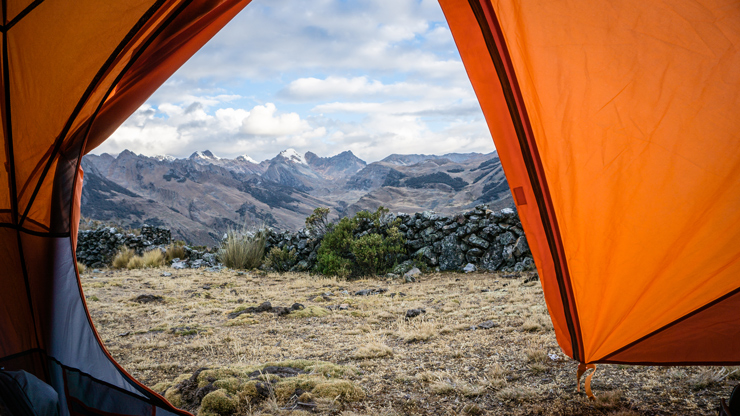
Before hitting the Huayhuash circuit, we spend 3 nights in Huaraz, from where we did 2 day hikes in the Cordillera Blanca, and didn’t take any medication. Apart from the quite hard headache after our first day hike, we didn’t experienced any problems after all. But do take this seriously, as the Huayhuash Circuito doesn’t allow you to descend to a sufficiently low altitude when feeling sick. Luckily, the Huayhuash route has the advantage of camping at a lower altitude than you’ve been earlier that day. Besides, the highest passes are in the second half of the circuit. This all helps to adjust steadily to the thin air.
Water
There are plenty of water sources in the valleys to allow you not to carry loads of water with you. A bottle of 1.5 litre per person should be fine.
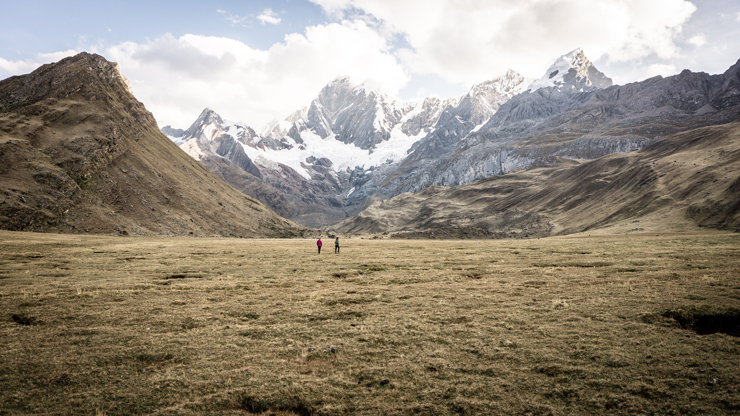
Be aware though that the valleys are pastures for livestock and sheep. Hence, use a water purifier that also combat viruses. Traditional water filters usualy don’t provide protection for viruses. We found a pen-style UV purifying device very convenient. The water sources are clear so they don’t require you to prefilter.
Toilet and washing facilities
Primitive toilets are available at the campsites. Be sure to bring your own toilet paper.
![]()
Don’t expect any bathroom facilities on the entire Huayhuash circuit. Why wash, right? That’s exactly what makes the Viconga hot springs so blissfully welcome halfway the trek. There are three pools: one is used to clean yourself, the other two are to relax and enjoy the scenery in a very special way.
Navigation
Be sure to bring any kind of navigation with you, as you’ll be hiking in a remote area.

If you stick to the classic route with just some minor deviations, an offline (!) map on your smartphone can be sufficient. Your smartphone doesn’t need connection for the GPS to be working. We found Maps.me to be very useful. Be sure to download the map beforehand and provide enough charging capacity and/or a solar charger.
In other cases we recommend bringing a topographic map, which you can buy in Huaraz.
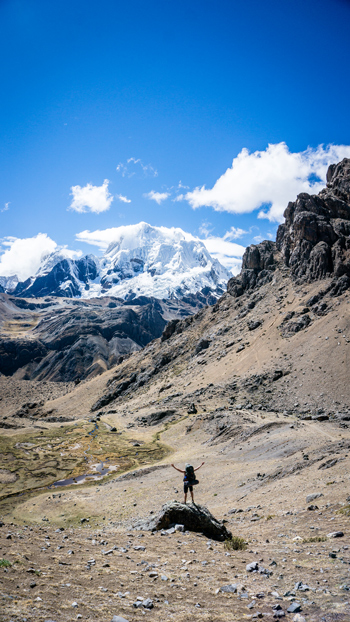
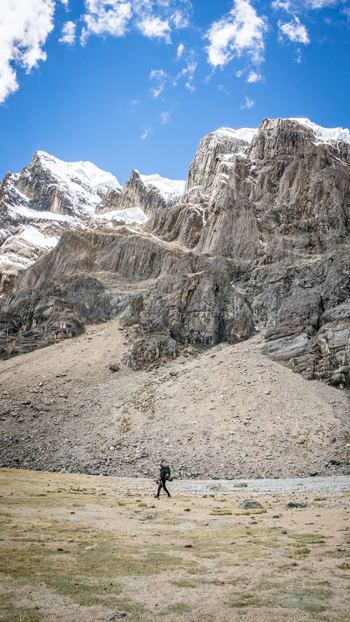
Packlist
Essentials:
- Backpack (65L)
- Tent
- Sleeping bag (up to -10 °C / 14 °F or better)
- Sleeping pad
Cooking:
We love the ease and taste of freeze-dried food. Mountain House is our favorite!
- Stove
- Lighter
- Pot
- Cutlery
- Meals (e.g. granola and freeze dried meals)
- Snacks (e.g. energy/protein bars)
- Water bottle
- Water purifier (that is effective against viruses!)
Clothing:
Think in layers! Some moments you’ll be hiking in tank top, other moments with hat and gloves.
- Hiking shoes
- 3 x pair of hiking socks
- 3 x underwear
- Down/Synthetic jacket
- Rainjacket
- 2 x light-weight sweaters
- 2 x zip-off trousers (or 2 x shorts + 2 x long trousers)
- 2 x quick-drying T-shirts
- Thermal underwear (for the nights)
- Pair of wool socks (for the nights)
- Cap
- Hat
- Gloves
- Swim wear (hot springs)
Electronics:
Be aware that you won’t be able to find any power supply during the trek.
- Camera
- Headlights
- GPS or smartphone with offline map
- Charger/Powerbank
- Spare batteries
Toiletries:
You won’t need much, as there are no bathroom facilities, only the hot springs.
- Biodegradable soap/shampoo
- Toothbrush and toothpaste
- Toilet paper
- Wet wipes
- Sun screen
- Lip balm and/or Vaseline
Other:
- First aid kit
- Hiking pole(s)
- Towel
Still some questions? Feel free to ask below!


Allo, my wife and are planning to do the whole circuit in 2020. Do you recall the name of the private transportation company you have booked in Huaraz to bring you to Matacancha ? We would like to d the same: hike independent, but used private transport.
Pierre
Unfortunately not.. We have search for it, but haven’t found it. We joined a group of Dutch hikers, who already booked the transportation. But I’m sure Google can help you out, there are several companies who can provide the trip. We only used it one-way, to go to the start. Afterwards we used public transport, so we could have still changed our itinerary if necessary. Good luck and ENJOY!!
Hi there,
This is a great post thank you, I am planning to do Huayhuash next week and wanted to see how much do you think you spent in total for the trip? Just roughly. Was it much different then what you would pay to do it with a guide?
Thanks
Alex
Hi Alex. Great you will hike the Huayhuash Circuit! No doubt it will be an experience of a lifetime! Actually, we only paid 240 soles per person for the whole trip (plus food ofcourse). That is 50 soles for transportation and 190 soles for the campsites. We brought our own gear, so we didn’t need to rent any. If you check the prices of an organized trip, you’ll quickly see that the difference is huge indeed. If you doesn’t have experience with multiday hiking trips, a guided trek is certainly a good option to see this beautiful piece of nature! Realize that carrying a heavy backpack results in a challenge of a whole other level. However, we always enjoy to have such a stunning landscape all for ourselves. That makes the extra challenge so worth it… 🙂
Hoi,
Super goe geschreven.
Tziet er echt de moeite uit.
Hopelijk kunnen ik en Matti julie tips gebruiken en deze hike ook eens doen!
Thanks, Debbie! Gewoon doen! 🙂 Deze trail zal enkel maar bekender en dus drukker worden. En dat zou wel eens sneller kunnen gaan dan we zelf willen.